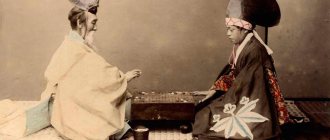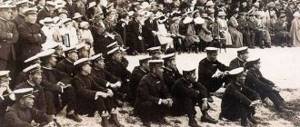75 years ago, on May 3, 1946, the Tokyo Trial, an international tribunal of Japanese war criminals, began.
In light of this date, it is regrettable to see that the words of the official representative of the Russian Foreign Ministry Maria Zakharova about the danger of deploying American intermediate- and shorter-range missiles in the Asia-Pacific region caused a strong reaction among readers of the Japanese media.
In particular, one of them stated that not simple missiles should be deployed in Japan, but certainly nuclear ones, in quantities of at least 500: “And if you can, then strike! Turn Russia into a sea of fire!” Another believes that such harsh phrases are inappropriate, since Japan will lose the clash even in this case. In his opinion, it’s time for Japan to rely only on its own strength: “Citizens need to correct their pacifist mood to a more decisive one.”
In the recent history of Japan, there was a significant period of time when the nation managed to be imbued with these very “decisive sentiments.” of Sciences, writer, senator of the International Association of Prosecutors, and from 2000 to 2021 Deputy Prosecutor General of the Russian Federation from 2000 to 2021, talks about what such calls led to then and to what abyss one can slide if one indulges base instincts.
– In the first half of December 2000, the world media reported that an international tribunal was sitting in Tokyo, which was investigating crimes committed by the Japanese army during World War II against “comfort women” - women who were forced to provide sexual services to the military.
"We accuse!"
The tribunal was initiated by non-governmental organizations and was supported by a number of women's groups from six Asian countries under Japanese military rule during the war.
The tribunal was attended by 60 women from China, East Timor, Indonesia, the Netherlands, North Korea, the Philippines, South Korea and Taiwan. They spoke about sexual crimes committed against them. More than a thousand people attended this unusual trial.
Lawyers took part in the meetings and took on the role of public judges. They heard testimony from victims of "sexual slavery" that was found to have been sanctioned by the Japanese government. Prosecutors have aimed to establish the responsibility of senior military ranks of the Japanese army, including the Emperor of Japan, for committing crimes against women. Here's what they managed to find out.
The world against the Japanese generals. History of the Tokyo Trial Read more
Classification of priestesses of love2
The future of each representative of the ancient profession depended on the skills of mastering sexual techniques and external data (female beauty). Girls in brothels could be:
- Geisha is not a prostitute in the usual sense of the word. Such a woman knew how to organize tea ceremonies, sing and entertain guests, she was very interesting to talk to. Sex with her could only happen with her consent. Only representatives of the upper strata of society could afford such companions. What qualities did a geisha have? Read on at the link!
Women who were unable to reach heights in their art became joro (courtesans); they had their own gradation of ranks.
- Age-joro were considered professional courtesans. In front of them were the Hashi-joro, etc.
- Otmise-joro was the name given to girls who were not officially registered but provided intimate services to men.
Promising idea?
During the war, according to various sources, there were from 200 to 400 thousand women from China, Korea and other countries in special brothels for Japanese soldiers. The so-called “comfort stations”, otherwise known as field brothels, began to open back in the 1930s. In 1932, Lieutenant General Yasuji Okamura approached the command with a plan to organize brothels for the army. He motivated his proposal by the fact that Japanese soldiers massively rape women, and in the process become infected with sexually transmitted diseases from them. And because of these acts, anti-Japanese sentiment among the local population is intensifying. The idea was approved in the highest Japanese circles, and “comfort stations” began to appear throughout Asia.
The first “station” was opened in Shanghai. The Japanese military authorities planned to have one sex slave for every 30 soldiers and officers. Advertisements posted by the Japanese on the streets promised “jobs for girls”; they were invited to become “a special type of nurse” for decent money. “A special type of work” resulted in imprisonment in brothels. And it was impossible to get out of this trap.
Sex slaves for the emperor's soldiers. How Japan is paying for old sins Read more
History
The Tokugawa dynasty volunteered to solve the sexual problems of Japanese men. In 1617, the shoguns of the dynasty decided to create a special quarter in the city of Edo (ancient Tokyo). The name of this area means "Reed Field" - Yoshiwara.
In the Edo era, the windows of houses in red light districts were distinguished by green and blue colors, they were called green gazebo or blue chambers. Gradually, similar areas appeared in other large cities of the island state.
Gradually, the most popular and respectable “relaxation zones” emerged:
- Shimabara existed in Kyoto.
- Shimmachi was opened in Osaka.
In these places, a Japanese, with the help of hard cash, could count not only on a woman of indescribable beauty, but also on exotic types of sexual intercourse.
The Japanese brothel invited only the best representatives of the fair sex to work. They had to master the most sophisticated sex techniques, which ordinary women had no idea about. The moth or Yujo would dry the sea cucumber and place it on the client's genitals.
In such establishments, a man could experience a whole range of emotions from the art of seppun - the Japanese kissing technique.
These were not ordinary areas, like in Europe. Here a man could achieve maximum harmony after a night spent.
The ancient red light districts weren't just about girls. Comedians, dancers, singers, fashionistas, artists and other similar professions have been involved in this industry.
"Pitch Hell"
A private paid an entrance ticket, which cost 5 yen; for officers, the entertainment was cheaper - they asked for only 2 yen for a ticket. The girls lived in inhumane conditions - they had to serve 20-30 soldiers a day, and after the popularity of brothels grew, this number reached 50-60. The operating hours of the brothels were strictly regulated, and the maximum possible time a soldier could spend with a girl was also indicated - at first it was 30 minutes, then it was reduced to 10-15 minutes... Doctors “worked” with the girls, who were supposed to monitor their health, but they did not differ in any way professionalism, nor mercy. On the contrary, many doctors themselves raped those of their “wards” who were healthier.
“Comfort stations” were located, as a rule, in ordinary barracks, surrounded by barbed wire. There was nothing in the rooms except mats and a sink. In order to forget themselves and not go crazy from horror and humiliation, many girls from the “comfort stations” stole opium from the soldiers, some tried to commit suicide: they ate handfuls of medicine, hanged themselves on towels and their clothes. Here are the words of Korean woman Park Yong Sim, whose story became public: “The Japanese soldiers all rushed at me like angry animals. There were ten of them. The next day - already thirty... If one of the women tried to resist, then punishment immediately followed: they kicked him, stabbed him with a knife. Or, if the “offence” was great, they cut off the head with a sword... The camp brothel was a complete hell. Every day, amid the roar of shells and bombs, I was forced to satisfy the sexual lust of dozens of Japanese soldiers. Almost all the women driven into camp brothels died from disease, beatings and bombing.”
“Even lower than brutes.” The most terrible experiments on people were carried out by the Japanese Read more
Hunting for women
By the way, it was Korean girls who were considered a particularly valuable “commodity” - they spoke Japanese well, because since 1910 Korea had been a Japanese colony. Korean women had absolutely no rights. Nevertheless, the Japanese initially created a kind of information curtain. When “voluntary” labor groups began to be formed from Korean women, it was promised that they would work in weaving factories, as secretaries in the armed forces, and as medical staff. But very soon the times came when few people believed the promises. Therefore, the “comfort station” kidnapped girls they met on the streets or captured in their own homes. Here is the story of the Japanese Yoshima Seichi : “I was a hunter of Korean women in camp brothels for sexual entertainment of the Japanese soldiers. 1 thousand Korean women were taken there under my command. Under the supervision of armed police, we kicked women who resisted and took away their babies. Throwing away the kids running after their mothers, we forcibly pushed the Korean women into the back of the truck, and there was a commotion in the villages. We sent them as cargo, on freight trains and on ships. Undoubtedly, we did not recruit them, but drove them away by force.”
Future sex slaves included both little girls and teenagers. Most were 15–17 years old. They took everyone, even non-locals. For example, a Dutch citizen was kidnapped and had to spend several years in a brothel until the liberation of the island of Java in 1945.
Having gained experience from the German Nazis, the Japanese at these “stations” began to use “medicine” for birth control. The so-called “drug 606”, containing a huge amount of arsenic in its composition, was widely used - it was used to terminate pregnancies in “workers”. Among the effects of this drug were the provocation of miscarriages, the possibility of developing infertility, the death of a pregnant woman...
A new monument to victims of Japanese sexual violence has been erected at a botanical garden in Gangwon Province, South Korea. The sculptural group consists of a sex slave sitting on a bench and a man kneeling in front of her with his head bowed. It is not difficult to recognize him as Japanese Prime Minister Shinzo Abe. The monument is called "Eternal Redemption". Photo: www.globallookpress.com
"Comfort Stations" for Japanese Soldiers
Almost every day, Lieutenant General Yasuji Okamura received more and more reports that spoke about the crimes of Japanese soldiers.
Most often they were accused of raping women in the occupied territories. The problem promised to become too serious, so Okamura decided to create special “comfort stations.” According to the general, they could influence “the reduction of anti-Japanese sentiment that arose in the occupied territories, as well as for the sake of the need to prevent a decrease in the combat effectiveness of soldiers due to the appearance of venereal and other diseases in them.” Local women staff
According to the original plan, only Japanese women were to work at the stations, and voluntarily. But this was soon abandoned because few women agreed to be prostitutes. Therefore, it was necessary to attract women from the occupied territories to “service”. Most often, Korean, Chinese and Taiwanese women acted as “comforters”. Japanese women were also present, but their numbers were disproportionately smaller. There is information that there were several women from the USSR, as well as some European countries, at the stations. But these are isolated cases.
At first, the Japanese tried to fill military brothels with female volunteers. But, of course, there were absolutely not enough of them. Therefore, they began to lure the “servants” with deception. The girls were promised jobs and good salaries. But in the end they became not seamstresses, nurses or cleaners, but sexual slaves. When things got underway, these tricks no longer helped. More radical measures were required. Then the recruiters visited the villages and offered the poor people money for their wives, sisters and daughters. After the deal was completed, they became the property of Japan. If for some reason it was not possible to buy a girl, threats and beatings were received. In addition, high-quality “products” were sometimes simply stolen. In general, the recruiters tried their best to do their job in order to provide the Japanese soldiers with a complete and comfortable “rest.” But soon this resource was exhausted. Therefore, they decided to involve captured women and girls from concentration camps in the “case.”
This is what the Japanese Yoshima Seichi from the Yamaguchi Society of Laborers recalled: “I was a hunter for Korean women in camp brothels for sexual entertainment of the Japanese soldiers. More than 1,000 Korean women were taken there under my command. Under the supervision of armed police, we kicked women who resisted and took away their babies. Throwing away the two- and three-year-old children running after their mothers, we forcibly pushed the Korean women into the back of the truck, and there was a commotion in the villages. We sent them as cargo in freight trains and on ships to the command of the troops of the western part. Undoubtedly, we did not recruit them, but drove them away by force.”
“Comfort Stations” (also often called “Comfort Battalions”) were positioned not only as “workhouses”, but also as a means to protect soldiers from venereal diseases. A “bonus” was the control of the number of rapes in captured settlements. It is clear that none of the versions could justify the abduction and deception of women, girls and girls. But the population of the occupied territories preferred to remain silent and not interfere with the Japanese. Any attempts to stop them were severely punished.
The number of stations grew at an alarming rate. For example, in China alone, approximately three hundred military brothels were created for Japanese officers and soldiers. The number of stations in other countries is not known exactly. According to rough estimates, there were more than four hundred “Comfort Battalions” in Southeast Asia.
As already mentioned, the idea of “comfort stations” was proposed by Lieutenant General Yasuji Okamura. He explained to his superiors that such establishments were capable of changing anti-Japanese sentiment, which was caused by the aggressive behavior of the soldiers of the Land of the Rising Sun. In addition, the stations could reduce the incidence of various sexually transmitted diseases.
The management approved and supported the idea. They decided to divide the stations into three types. The first implied complete submission to the military, and the condition of the girls was monitored by professional doctors. The second option was control by private individuals. But at the same time, they themselves were subordinate to the military. The third type - the rarest - was a station not only for the military, but also for ordinary Japanese. There were even exceptions when men of other nationalities were allowed to use it. But this is rather an exception.
In theory, the number of rapes should now, if not drop to zero, then at least become less frightening. But in reality it turned out differently. The number of raped Chinese, Korean and women of other nationalities only began to increase. The fact is that the “comfort stations” were not free organizations. You had to pay for a meeting with the “comforter”. Moreover, for many soldiers the amount was substantial. So they either resorted to violence or found cheaper places. And even though they were not official, there was a health hazard; the soldiers took risks, not wanting to spend money. For ordinary soldiers, the cost of services was five yen. And for officers and corporals, “comforters” cost three yen less.
welcome to Hell
Women who were forced or deceived into the category of “reduced social responsibility” lived in hell. Every day they had to serve several dozen men. Twenty to thirty clients was considered “hack work.” There were usually between fifty and sixty soldiers per day. The work of the station was clearly regulated, down to the time allocated per soldier. When the network of brothels was just unfolding, a military man could spend half an hour on consolation. Over time, when the stations began to gain popularity, due to the influx of visitors, the time was cut in half (in some brothels, ten minutes were allocated for “everything about everything”). When the minutes were up, the soldier left the room, and another immediately took his place. And so from morning to evening. Often women did not have even five free minutes.
Here are the memories of Yoshima Seichi about the everyday life of comfort stations: “One Korean woman was raped on average 20-30 per day, even more than 40 Japanese officers and soldiers, and in mobile brothels - more than 100. Many Korean women tragically died due to sexual violence and brutal oppression by the Japanese sadists. Having stripped the disobedient Korean women naked, they rolled them on boards with large nails driven upward, and cut off their heads with a sword. Their monstrous atrocities exceeded all human imagination.”
The life of the “comfort women” was reminiscent of the proverbial Groundhog Day, in which they were simply trying to survive. Of course, almost every second person couldn’t keep up with the set pace. Therefore, the mortality rate in brothels went through the roof. Officially, all female workers were under the constant supervision of doctors. But most often this “control” was limited to the rape of their wards. According to statistics, nine out of ten women suffered from severe depression, which resulted in suicide or attempted suicide. By the early forties, suicide for stations had become the most common, banal thing that no one paid attention to. In order to achieve their cherished goal - to give up their lives - women decided on various tricks. Someone, for example, stole opium from clients and powerful drugs from doctors. If it was not possible to get anything, then one’s own clothes were used.
The age of the “comforters” varied from eleven to thirty-something years. They all lived in identical conditions - wooden barracks, in rooms designed for nine to ten people. The furniture consisted only of couches, a sink and a mat. Women were forbidden to leave their “abode”. Difficult living conditions put additional stress on the psyche. Depression, nervous breakdowns - all this has become commonplace, smoothly flowing into suicidal tendencies.
But there was another reason for the high mortality rate among women. Japanese doctors and scientists, having gained experience from their German colleagues, conducted various medical experiments on “comfort women.” At first, they decided to take control of the child birth rate. Their main weapon was “drug 606,” which contained a large dose of arsenic. And although contraception was strictly monitored in brothels, sometimes in 1966 there was a need to terminate an unwanted pregnancy in a female worker.
“Drug 606” provoked miscarriages, could affect the development of infertility, mutation of the fetus, and also lead to the death of the unfortunate patient.
Who's responsible?
Information about “comfort stations” became public knowledge after the infamous Nanjing Massacre. Photos of military brothels from Nanjing hit the press. This caused the first wave of indignation. The Japanese authorities reacted to this cold-bloodedly and cynically. They refused to acknowledge the existence of “comfort battalions.”
The first apologies were made only in the nineties of the last century. The surviving women, as well as the families of the deceased “comforters,” received “honor.” But already in 2007, Japan backed down. The Prime Minister said there was no evidence of violence against women. This gave rise to a second wave of indignation. Finding himself under pressure, he soon dared to admit the fact of human rights violations at the “comfort stations.” However, there was no talk of any financial compensation for moral and physical damage. The authorities of China, Korea and other countries criticized the Japanese government. By the way, the USA, Canada and the European Parliament took their side. Thus a resolution appeared that called on Japan to take responsibility for all the terrible events of that time.
The story of one Korean woman named Park Yong Sim became public: “At the age of 14, I was sold to a clothing studio in the Hupho quarter of the port city of Nampo (near the Korean West Sea) and worked there as a cook, and by March 1938 I ended up in Japanese “requisition.” girls... A Japanese ordinary policeman forcibly escorted me and a 22-year-old girl to Pyongyang. I see that there were already 15 Korean women at Pyongyang Station. First, in a closed carriage, and then by car, they took us to the Chinese city of Nanjing. There were many Japanese barracks there, and on Jinxui Street there was a camp brothel located in a three-story building. This is where my shameful life as a sex slave began. Each room was 2x2.5 m in size, and there was a barbed wire fence around the house.”
Park Yong Sim recalled that on the very first day she was brutally raped by more than ten men: “The Japanese soldiers all rushed at me like angry animals.” And the next time their number grew to thirty.
Here is another excerpt: “If someone tried to resist, then punishment immediately followed: they kicked them, stabbed them with a knife. Or, if the “offense” was great, they cut off the head with a sword... The camp brothel was a complete hell. Three years later I was transported to Shanghai, and from there to Russia near Rangoon in Burma. There, under the name “Wakaharu,” I had to serve Japanese infantrymen and tank crews. Two years later they were again transported almost to the front line - to the border of Burma and China. Every day, amid the roar of shells and bombs, I was forced to satisfy the sexual whims of dozens of Japanese soldiers. Almost all the women driven here into camp brothels died from disease, beatings and bombing. Then the barely surviving Korean women, along with soldiers of the defeated Japanese army, were sent to a prisoner of war camp in Kunming, China. Later I returned to my homeland, but as a cripple - due to heart disease and a disorder of the nervous system, I rush around in delirium at night. Every time those terrible days are involuntarily remembered, the whole body trembles with burning hatred for the Japanese. I lived without knowing either family happiness or the joy of a mother in labor. Thinking about my ill-fated past, I recall in my memory many compatriots who in a foreign land were subjected to all sorts of torments and became restless souls. Moreover, the Japanese government shamelessly arranges all sorts of intrigues, trying to hide its crimes in the shadows of history. "I call on the conscience of the world to put pressure on the Japanese government to acknowledge the crimes of the past, take responsibility for them, and try to compensate for the suffering of innocent people."
The authors of the book “History of Korea” did not ignore the comfort stations: “In an effort to hide their crimes from their allies, the Japanese army in many cases destroyed them during retreats in 1943-45. their sex slaves, which is one reason why few of them survived—in the 1990s, there were about 200 registered former sex slaves in South Korea and 218 in North Korea.”
In total, during its existence as a tool for consolation, from fifty to three hundred thousand women from China, Korea and Taiwan passed through military brothels. Sometimes more impressive figures flash by. But the position of the Japanese government still remains unchanged. The authorities of the Land of the Rising Sun are trying with all their might to absolve themselves of responsibility for the war crimes of past years.
Monument to Comfort Women in Korea
Covering my tracks
In an effort to hide their crimes, the Japanese army in many cases simply destroyed them during retreats in 1943–1945. unfortunate sex slaves. When the city of Xuncheng, located near Nanjing, was temporarily liberated from the Japanese, the Chinese discovered a building containing the naked bodies of dozens of Chinese women who had been killed by the Japanese before they were driven out of the city. A sign above the front door read: “Comfort Station of the Great Imperial Army.”
After World War II, General Okamura, was recognized as a war criminal in China, but thanks to the protection of Chinese leader Chiang Kai-shek, he managed to return to Japan.
The Women's Tribunal in 2000 recalled that the Tokyo International Tribunal 1946–1948. did not consider the facts of sexual crimes, although acts of sexual violence committed during military conflicts constitute “crimes against humanity”, that is, they are war crimes subject to criminal punishment.
Tokyo International Tribunal 1946–1948 really did not consider military violence against women as a separate crime. True, evidence of what Japanese troops did during the massacre in Nanjing was heard and presented. And these facts indicated that not just excesses took place - a specially developed and approved state program was being implemented. We can only hope that this is no longer possible today.








